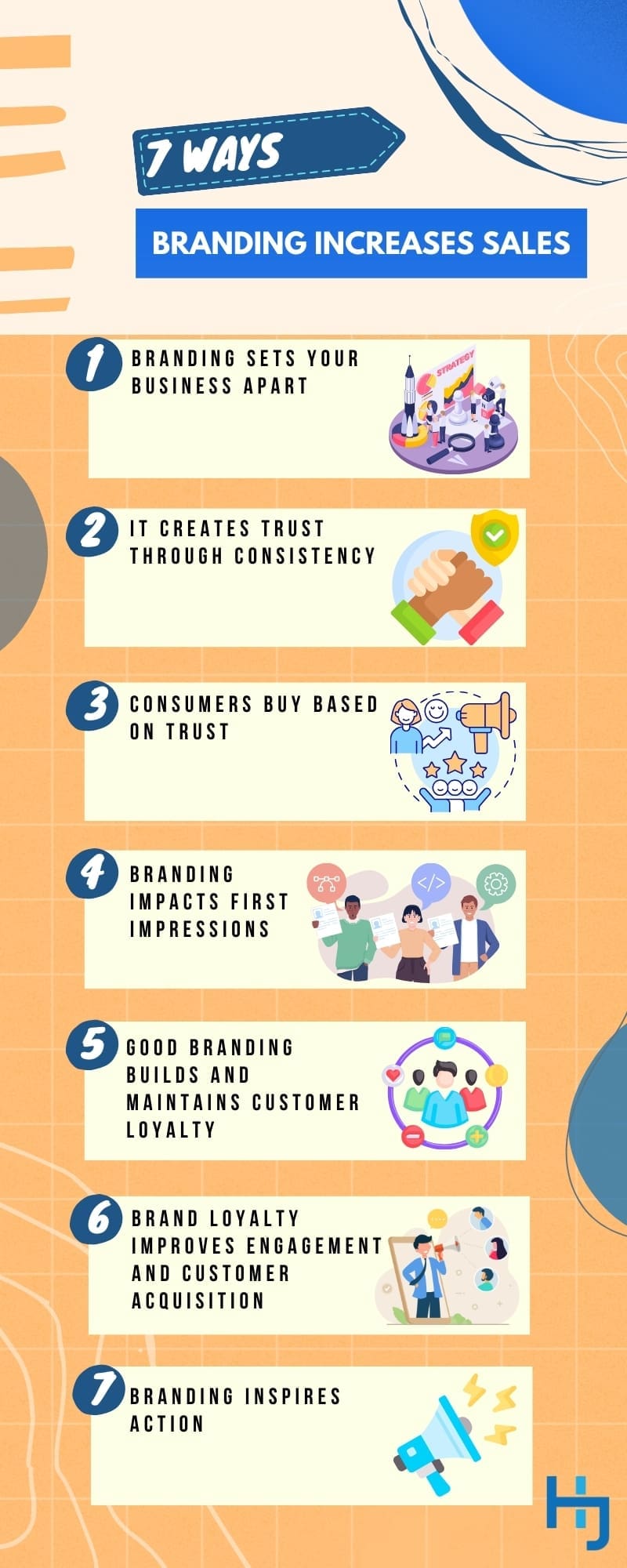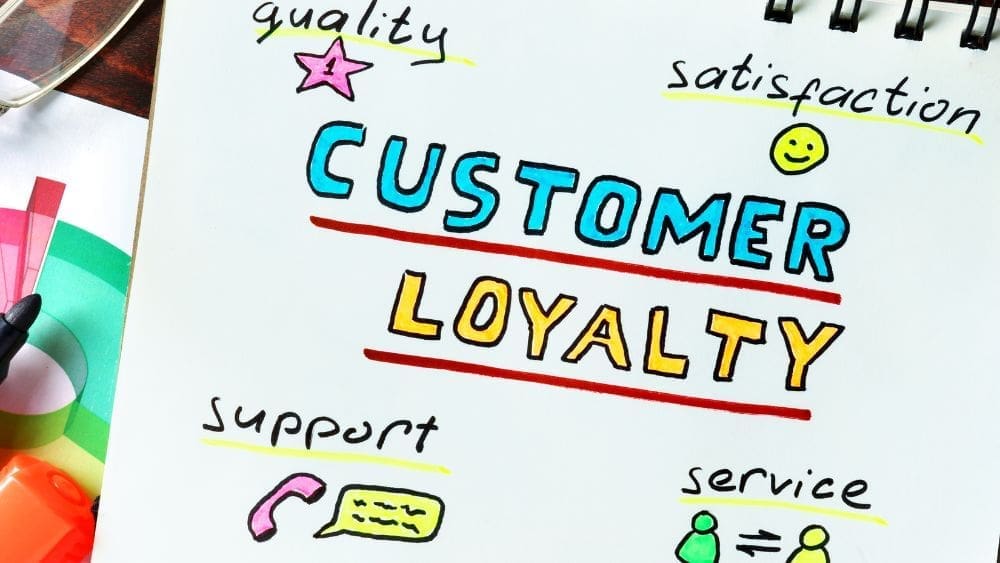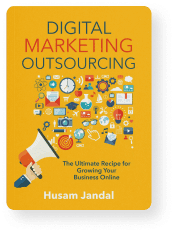
If you’re looking for ways to boost online sales, start with branding. As unconventional as it may seem, it works. While most businesses double down on marketing efforts to boost leads or build up their sales team in an attempt to close more deals, neither of these methods delivers as consistently as branding does.
But, how does branding increase online sales? Let’s explore how smart branding strategies fuel consistent growth and turn customer interest into lasting revenue.
What’s the Difference Between Branding, Sales, and Marketing?
Under traditional models, businesses focus on sales and marketing. Teams work independently and branding is something that happens in the peripheries.
Modernized teams generally recognize that sales and marketing need to work together to achieve results, but they don’t always nail the mechanics of alignment, and branding remains on the sidelines.
It takes a joint effort in all three areas to create healthy, thriving businesses, but branding is the keystone.
Marketing
Marketing is about generating interest or creating leads. It involves creating demand for a product or service—reaching the right person with the right message at the right time.
Sometimes, marketers cast a wide net. You’ll see examples of this during the holiday season, such as Christmas, when all outlets from TV through radio and online advertising are packed with messages about family or the stress of the holidays. The marketing team has the right message at the right time and, because it’s reaching a wide audience, it’s likely to strike a chord with the right person too.
This has been the only form of marketing available historically. If you think about the marketing channels our grandparents and great-grandparents had, it’s night and day. Maybe they had a publication or two and picked up the occasional show. Marketers could put out information on a major network, and it would reach 70 percent of the viewing audience, according to NBC.
Things are a bit different today. If you cast a wide net, your marketing message gets caught in the noise. Research from Forbes indicates people now see as many as 10,000 ads on any given day. Businesses now use tactics like targeting a specific target audience and personalization to fight for attention, but even this doesn’t work by itself. New sales strategies are always being invented and used to ease the sales process and attract new customers, but not just any customers, the ideal customer base for your specific products, especially with the prevalence of digital marketing efforts.
Sales
Sales is the process of turning the demand and interest into a purchase—converting a lead into a customer. It complements your marketing goals.
Again, you can think of it in the traditional sense, with the salesperson homing in on a lead and breaking down barriers until the sale is made, or you can think of it with the modern flair. For example, maybe you receive an email that one of your favorite companies is releasing a new product. You click the link in the email, read about it, and add it to your online cart, but then you stop. Perhaps you had to dash off to work, your family needed something, or you hesitated due to the expense. The marketing plan got you to that point. It’s the job of sales to close you. A savvy sales team will know that you clicked and might call you right away to see why you stopped, or they might presume it was a money issue and send you a discount offer if you complete the transaction right away.
Branding
Think of branding as a set of signals that tell people what your business is about—who you are, what you do, and how you do it. Many people differentiate further between “branding” and “brand.” Branding, then, covers the distinct symbols that represent your company, such as your logo, graphics, color palette, fonts, and so forth. The brand is then the overall package—the sum of your branding and what your company stands for. When it’s done well, however, the two are interchangeable.
For example, unless you’re a marketing or psychology buff, you’ve probably never once marveled at Apple’s minimalistic approach. You may not have noticed how sparingly the company uses text and how much empty space appears in ads, on boxes, or even in their stores. That’s all branding. But you probably do associate mobile devices like the iPhone with things like luxury, efficiency, and exclusivity. That’s the brand.
How Branding Increases Sales
The benefits of building a good brand cannot be overstated. It’s the glue that keeps the various components of your organization joined and customers close. It keeps loyal customers and lures potential customers.

1. Branding Sets Your Business Apart
The way you brand your business can set it apart from others in the same niche. If you’re familiar with ride-sharing apps, you’ve probably noticed the difference between how Uber and Lyft brand themselves.
Uber launched as a more affordable alternative to hiring a private driver. Though the initial name was UberCab, the company was more like a hybrid between a taxi service and having a chauffeur. Its logo represented this—hard edges of white on a black background.
When Lyft came onto the scene, its offerings weren’t remarkably different, but the brand was. The company appealed to customers’ emotions by distinguishing itself as being fun and friendly. Cars had pink mustaches, and passengers were encouraged to sit in the front seat so they could easily chat with drivers. It worked. Uber has repeatedly rebranded itself in an attempt to be perceived as more friendly, down to overhauling the logo to give it soft edges and updating its offerings. When we place this in the context of today’s crowded marketplace, in which consumers see 10,000 ads per day, it’s easy to see how good branding pays off.
2. It Creates Trust Through Consistency
Pause for just a moment and picture a Ferrari in your mind. Think it through. What color is it? Chances are, you pictured a red car. Silver, black, or white might also have been in the minds of a small portion of readers. There’s one color that nobody familiar with the brand likely pictured—pink. Ferrari doesn’t allow it.
“It just doesn’t fit into our whole ethos, to be honest,” the company CEO explained to news outlets a while back. “It’s a brand rule. No Pink. No Pokémon Ferraris!”
While businesses don’t need to take branding to this level, it’s a clear example of the impact of consistent branding. Ferrari has stringent standards designed to protect the integrity of its brand. Consumers know what to expect. They know the prestige of owning a Ferrari isn’t going to diminish. It’s also one of the many reasons the brand can command higher prices. Your organization may not be dedicated to selling $300,000+ cars, but the concept translates to all types of businesses.
3. Consumers Buy Based on Trust
Research from Edelman shows 53 percent of consumers will buy first from a company they trust, while 51 percent will advocate on behalf of the company, and 43 percent will defend it.
Presenting your company as a trustworthy brand isn’t enough, though. As I explain in “Why Branding is More Important than SEO,” your branding must be authentic, too. Whatever your brand signals are, be it promises of value, customer satisfaction, social responsibility, or something else entirely, you must embody those values to build the trust that comes with them.
4. Branding Impacts First Impressions

There are several ways to look at first impressions and branding. To start, the first impression must match the customer’s experience. If there’s a disconnect between the two, you’ll lose customers as soon as you pick them up.
The second component of this is that customers won’t just leave. Just as customers who trust you will defend you and advocate for your brand, those who become disenchanted will often become detractors, leaving negative reviews that create a poor perception of your brand for future customers.
Lastly, there’s the Colgate dinners phenomenon. Images of TV dinners, sometimes lasagna or “Kitchen Entrees,” began popping up a few years back. If you saw them, you no doubt pondered why a toothpaste company would ever think making food was a good idea. There’s some debate as to whether the infamous TV dinner ever existed, as Harry Harris explains in Prospect, but the ad images are typically used as an example of poor marketing or bad business ideas. They’re not, though. It’s a branding issue. The brand represents minty oral health, and the company has done an excellent job of differentiating itself as such.
All of these examples underscore one critical point. Your brand identity is a major deciding factor in whether a person is even open to hearing your marketing message. Furthermore, your first impression sets the tone and serves as a promise to the customer. Honoring the promises you make is essential to building a healthy business.
5. Good Branding Builds and Maintains Customer Loyalty
When branding genuinely reflects how your company and team operate, it fosters long-term trust and loyalty.
According to Edelman research, loyal customers are more likely to:
- Choose your products over competitors
- Overlook negative reviews or temporary issues
- Stay with your brand, even if others become trendier
- Remain loyal during mistakes or product problems
- Ignore boycotts and stick with your values
- Pay premium prices for your services
In short, strong branding doesn’t just attract—it retains. It makes your business more resilient, even when conditions change.
6. Brand Loyalty Improves Engagement and Customer Acquisition
Loyal customers don’t just stick with your business—they become your brand’s biggest advocates.
Research from Accenture reveals:
- 43% of customers increase spending with brands they love
- Over 50% recommend those brands to family and friends
Strong branding turns satisfied buyers into promoters—people who bring new customers to you, fueling growth through trust and word-of-mouth.
7. Branding Inspires Action
The buyer’s journey is not what it once was. Customers don’t simply rely on a single TV spot or publication placement to determine where their dollars are spent. Again, they’re met with up to 10,000 ads per day on Facebook, Twitter, and email marketing from products and services that are seemingly interchangeable at a glance. If something piques their interest, they’re going to research it. Nearly 90 percent do, according to the latest B2C Ecommerce Report.
Savvy brands know this, and so they pepper the customer’s path with branded materials to help them decide in the company’s favor. You’ll see blog content that offers solutions to the customer’s problems, case studies to prove the company can help, and special offers and gifts to eliminate any final barriers. They also continue their messaging after the sale with referral and testimonial requests and valuable content that demonstrates their credibility and the value they’re bringing to the table.
Define Your Brand to Build a Strong Brand Identity
A strong brand identity begins with a clear understanding of who you are, what you stand for, and how you want to be perceived. Before you focus on promotion or visual elements, it’s essential to define your brand at its core.
Start by identifying the purpose of your brand, its mission, and the brand values that guide your business decisions. This foundational work not only aligns your team internally but also helps establish a consistent brand voice and brand personality—key traits that shape every interaction with your audience.
A successful brand strategy also includes a clear brand positioning statement, which defines how you want your business to be perceived in the market relative to competitors. This positioning strategy is central to communicating your brand message effectively and building a recognizable brand that resonates across all touchpoints.
To ensure brand consistency, formalize your decisions with clear brand guidelines. These should outline your visual identity (logos, typography, color palette), tone of voice, messaging pillars, and usage rules. Consistent implementation builds brand recognition, increases brand equity, and improves the overall brand experience—all of which contribute to a successful brand in the long term.
Whether you’re launching a new brand or evolving an existing one, developing a strong brand identity lays the foundation for an effective brand positioning strategy that can scale with your business.
Effective Marketing Strategies That Increase Sales
1. Consider Your Brand Before You Build It
Your brand will be the essence of your company going forward. Break out the types of messaging you want consumers to hear and how it differentiates you from competitors. Consider whether everything you’re laying out now is still going to suit you in the coming years and whether the values you’re assigning to your company are things you can stand behind in the long run.
2. Create Consistent and Clear Messages on All Marketing Platforms
Once you have a clear outline of your brand, use the same messaging everywhere to increase brand awareness. That includes your company website, social media marketing platforms, like Facebook, Twitter, LinkedIn, YouTube, Instagram, Pinterest, blog, email, ads, Google My Business profile, digital marketing strategies, digital marketing campaigns, podcasts, and anywhere else your brand may be present.
3. Pepper the Journey with Branded Content
Content marketing is your action accelerant. It carries your current and potential clients through your sales pipeline and creates lasting relationships. Best of all, you can measure the success of your content, track ROI, see when conversions happen, adjust when an area seems weak, and turn up the volume when a certain part of your sales funnel is performing well. Always adjust based on customer feedback and be willing to create a new business strategy.
Get Help Refining Your Branding Strategies and Increase Sales
As a marketing consultant and educator with a background in both business and marketing, I’m a huge proponent of an effective strategy that drives data. Branding works. I’ve helped some of the world’s biggest brands reach new heights, and I welcome the opportunity to help your company grow too. Contact me to discuss your needs.
































































